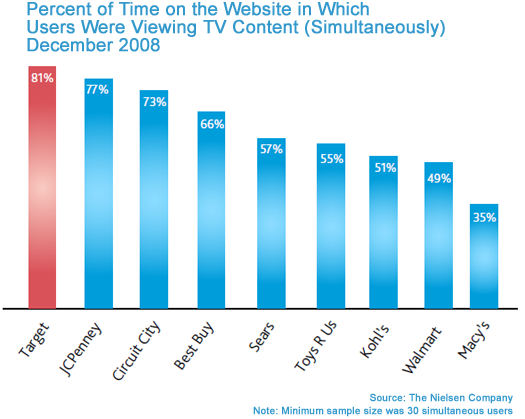
Jim O’Hara, President, Media Product Leadership, The Nielsen Company
The evolution of the three screens that distribute video – TV, Internet and mobile phones – has created challenges and opportunities for consumers, programmers and marketers alike. Consumers are exposed to more viewing options than ever before, while programmers and marketers have to find new ways to break through the clutter and deliver their message. Will the increased usage of the Internet and mobile phones take people away from traditional television viewing? How will consumers manage their use of the three screens? Separately? Simultaneously? How will these changes impact marketers? To address changing media consumption behavior, Nielsen developed the Anytime Anywhere Media Measurement (A2/M2) initiative, which seeks to measure consumers and their video consumption across all three screens. Through our A2/M2 initiatives, we have gained considerable knowledge into how people use the three screens.
The Findings
One of our primary tools for observing three screen behavior has been the TV/Internet Convergence Panel, which is made up of 1,000 households in the U.S. that formerly participated in our TV ratings panels. These households, accounting for almost 3,000 people, were asked to install a Nielsen software meter on their computers in addition to the meters these households had already permitted us to install on their televisions, enabling us to measure both Internet and television activity.
What we have found to date is that despite the initial presumptions and fears of some, media consumption has actually increased. Each of the three screens has its benefits and people are using them as complements, not as substitutes, for one another. With respect to TV and Internet usage, we found that a fair number of people are doing both simultaneously, though in relatively small increments per day – an average of ten minutes per day per person. In our multitasking culture, watching TV while checking e-mail or surfing the Internet has become more and more common: more than half of our panelists had some simultaneous activity. Among that group, 3.7% of the time they were watching television they were also on the Internet and 31.6% of the time they were online they were also watching television. What was rather unexpected was that this behavior was not limited to any one age demographic: a teen was as likely to be engaged in simultaneous usage as was someone 54 years old. And the amount of time they were doing this was comparable.
| Usage Level Per Day | ||
|---|---|---|
| Age | Simultaneous Reach% | Simultaneous Minutes per User Per Day |
| P2+ | 56 | 10 |
| P2-11 | 29.4 | 5 |
| P12-17 | 63.2 | 9.8 |
| P18-34 | 55.3 | 11.2 |
| P35-54 | 63 | 10.6 |
| P55+ | 60.2 | 9.7 |
| Source: The Nielsen Company |
| Who Uses the TV and Internet Simultaneously?
May 2009 |
|||||||||
|---|---|---|---|---|---|---|---|---|---|
| P2+ | K2-11 | T12-17 | A18-24 | A25-34 | A35-44 | A45-54 | A55-64 | A65+ | |
| Simultaneous Users Per Month (000) | 139,817 | 11,458 | 13,486 | 11,759 | 22,421 | 23,681 | 23,588 | 19,055 | 14,368 |
| Simultaneous User % | 62.1 | 36.6 | 65.6 | 51.3 | 74.0 | 69.0 | 67.1 | 70.4 | 60.9 |
| Simultaneous HH:MM per Simultaneous User per Month | 5:15 | 2:13 | 4:08 | 3:58 | 5:32 | 5:53 | 5:40 | 7:00 | 5:11 |
| % of TV Minutes spent while also using the Internet | 3.6 | 2.1 | 4.3 | 3.6 | 4.4 | 4.4 | 3.5 | 3.6 | 2.5 |
| % of Internet Minutes spent while also watching TV | 30.4 | 32.8 | 25.3 | 23.7 | 27.5 | 30.9 | 30.7 | 36.8 | 31.3 |
| Source: The Nielsen Company |
So who is sharing their time online with TV? Women age 25 and over and persons 35 and up are most likely to juggle the two media. Further, they tend to be above-average consumers of each platform. Simultaneous users watch 14 percent more TV a day and use the Internet 61 percent more than the average consumer. Clearly, during that expanded timeframe they are exposed to a large number of ads and the opportunity to reach them is greater.
Implications for Marketers
Until fairly recently, marketers would develop campaigns based on the individual medium – one for TV and another for the Internet. Often times, these campaigns would bear little resemblance to each other. But today, we know that doing so risks passing up an opportunity to reach a captive audience. The simultaneous usage phenomenon presents new marketing opportunities: the unique strengths of each medium can be leveraged to allow consumers to be reached – and allow them to reach back – in ways that they choose themselves.
For example, TV can deliver the call-to-action via advertising. The Internet can provide a convenient venue for the action, and enable the consumer to get more information about or actually purchase a product or service. Advertising that takes advantage of this linkage of platforms is already being implemented with particularly strong results.
To gauge the effectiveness of this concept, we looked at a few traditional retailers during the 2008 holiday season to see which of them were most successful in stimulating cross-platform behavior. In December, the highest percentage of people who watched TV while using retailer web sites went to Target.com Target was also among three retailer web sites (second to Walmart and before Best Buy) that were uniquely able to draw a high percentage of simultaneous Internet and TV users – 3.8 percent. Visitors to its web site were more likely to be watching TV while at the site, and 10.2 percent of Target.com visitors said that they had seen a Target commercial on TV. Based on these figures, it seems clear that the simultaneous use of the two media had a measurable effect on behavior.

All signs are that media consumption across screens will continue to grow. Advertisers and media outlets that develop ways to capitalize on consumer cross-platform experiences and leverage the strengths of each will likely benefit. Now more than ever, a call-to-action – be it to visit a web site for more information or to make a purchase – can yield an immediate reaction from the consumer using both TV and Internet. But regardless of the medium, the key to successful marketing is having the right message that can make a real impact with the target audience the advertiser wants to reach. With increasing numbers of consumers expanding their use of media, marketers have more opportunities than ever to do so.
We are now expanding the scope of the Convergence panel to include measurement of video viewing on mobile phones. So expect more from Nielsen on simultaneous usage, cross-platform measurement and marketing implications as the three screen evolution continues.



